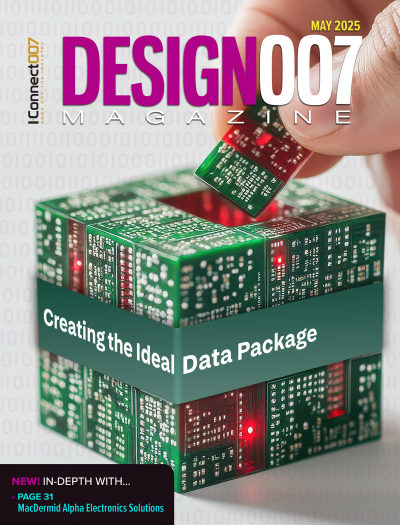-

- News
- Books
Featured Books
- design007 Magazine
Latest Issues
Current Issue
Showing Some Constraint
A strong design constraint strategy carefully balances a wide range of electrical and manufacturing trade-offs. This month, we explore the key requirements, common challenges, and best practices behind building an effective constraint strategy.

All About That Route
Most designers favor manual routing, but today's interactive autorouters may be changing designers' minds by allowing users more direct control. In this issue, our expert contributors discuss a variety of manual and autorouting strategies.

Creating the Ideal Data Package
Why is it so difficult to create the ideal data package? Many of these simple errors can be alleviated by paying attention to detail—and knowing what issues to look out for. So, this month, our experts weigh in on the best practices for creating the ideal design data package for your design.
- Articles
- Columns
- Links
- Media kit
||| MENU - design007 Magazine
Thermal Characterization of LEDs: Enabling the Upcoming Lighting Revolution
October 29, 2014 | Dr. John Parry, CEng., Mentor GraphicsEstimated reading time: 1 minute
According to a June 2012 report from the Climate Group, many commercially available, outdoor light-emitting diode (LED) products offer high-quality light, durability, and significant electricity savings in the range of 50 to 70%. More European cities are adopting LED streetlights because LEDs can save energy costs, while exceeding local lighting standards. They last 50,000 to 100,000 hours, change little in color, and have a failure rate of around 1%, compared, for example, to up to 10% for ceramic metal halide fixtures over a similar time period. LED streetlights are a gateway technology--when LED designers solve the current problems of reducing cost and thermal challenges, they’ll be paving the way for wider adoption and the energy-saving potential of LEDs.
Thermal management is one of the more complex areas of LED system design. And until a few years ago, the methods and technology to scientifically characterize the thermal behavior of the component, as well as its systems and subsystems, were not available. Instead, most engineers calculate their thermal needs from data sheets published by component manufacturers. Understandably, having data available to engineers on the specific thermal mechanics of LED-based devices within the system in which they are being used could be a huge step forward for future lighting designs.
This article describes a method that combines hardware measurement (a thermal transient tester), and computational fluid dynamics (CFD) software to provide high measurement throughput, which enables systems integrators to verify a vendor’s thermal resistance data during design and to test incoming commercial off-the-shelf parts before they are introduced into production. This data can be used during the design and product development phase to accurately capture the thermal response of an LED lighting system.
Read the full article here.
Editor's Note: This article originally appeared in the October 2014 issue of The PCB Design Magazine.
Suggested Items
Seeing a Future in Mexico
07/09/2025 | Michelle Te, I-Connect007The Global Electronics Association (formerly known as IPC) has been instrumental in fostering a partnership with Guanajuato, a state north of Mexico City with 12 industrial clusters and close to 150 companies involved in electronics. This past spring, Alejandro Hernández, the undersecretary for investment promotion in Guanajuato, attended IPC APEX EXPO 2025 at the invitation of IPC Mexico Director Lorena Villanueva, where he met with several companies to discuss the opportunities available in Mexico. He is inviting electronics-related companies seeking long-term investment in a centrally located area with access to highways, railways, and ports.
Webinar Review: A Global Trade and Economy in Flux
07/09/2025 | I-Connect007 Editorial TeamIn a July 8 webinar, Global Electronics Association Chief Economist Shawn DuBravac provided a comprehensive analysis of the evolving international trade environment, its implications for inflation, monetary policy, and labor dynamics, and a sober assessment of market valuations. In “Navigating a Shifting Landscape” DuBravac painted a picture of a global economy in flux, where shifting trade alliances and tariff structures are redrawing the supply chain map and influencing the broader economic landscape, while also conveying an overall bullish market outlook.
Zhen Ding Posts June 2025 Monthly Revenue Report
07/08/2025 | Zhen Ding TechnologyZhen Ding Technology Holding Limited, a global leading PCB manufacturer, reported June 2025 revenue of NT$12,823 million, up 19.68% YoY and up 8.75% MoM, setting a record high for the same period in the company’s history.
Study on Resonance Mitigation in Metallic Shielding for Integrated Circuits
07/08/2025 | Article by Maria Cuesta Martin, Victor Martinez, Vidal Gonzalez Aguado, Würth ElektronikInherent cavity resonant modes often lead to significant degradation of shielding effectiveness, responsible for unwanted electromagnetic coupling. Cavity resonant modes of the metal shielding enclosure can produce two adverse problems: the mutual coupling among different RF modules and shielding effectiveness reduction of the metal enclosure. The cabinets serve to shield certain components from electromagnetic interference (EMI). However, these cavities present some resonance peaks at 5 GHz, making it impossible to use them at higher frequencies.
Inside Aimtron’s Cross-border EMS Strategy
07/08/2025 | Nolan Johnson, SMT007 MagazineMukesh Vasani immigrated from a very small farming village in India to the U.S. in 1995 as a civil engineer. After shifting into electronics, Mukesh built his Chicago-based company, Aimtron, into a successful enterprise by combining quality with competitive pricing. He leveraged his roots in India to expand manufacturing without compromising on quality.


